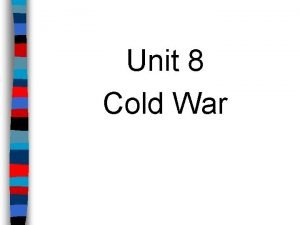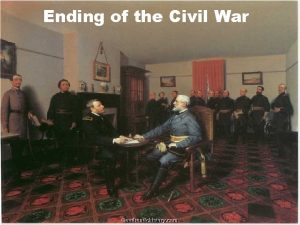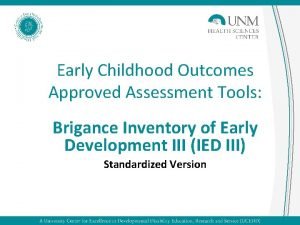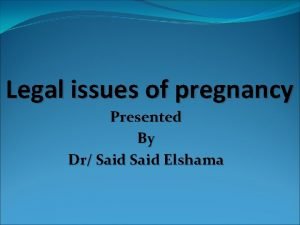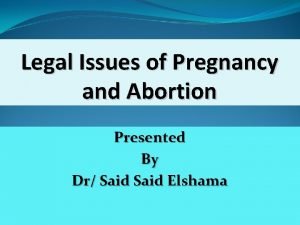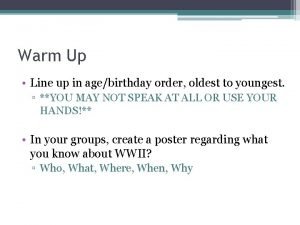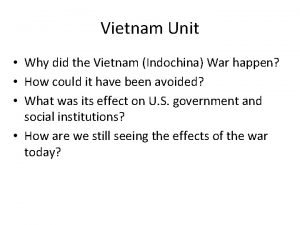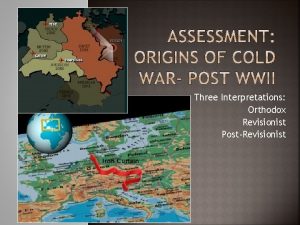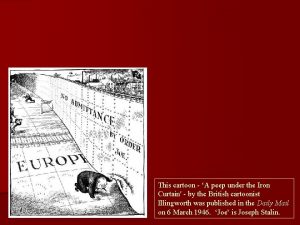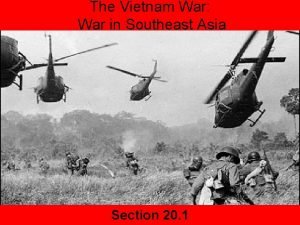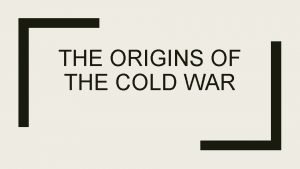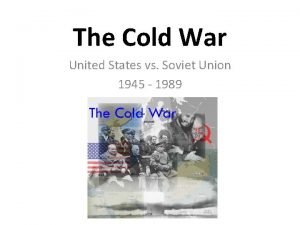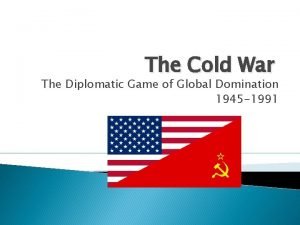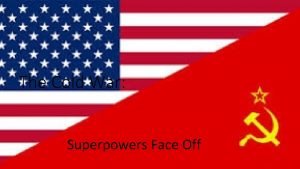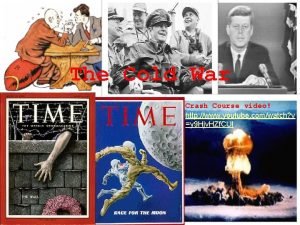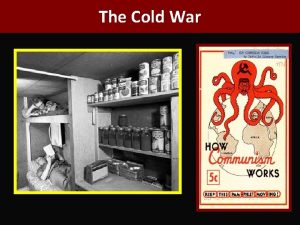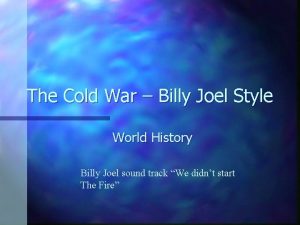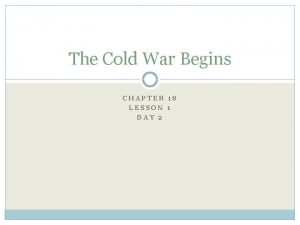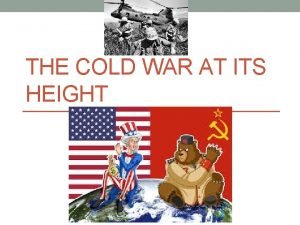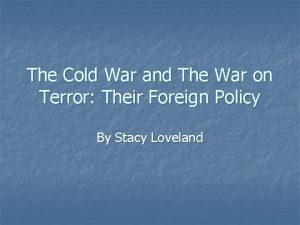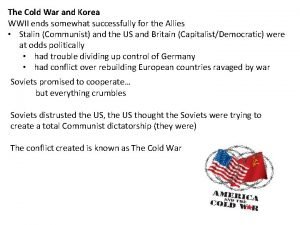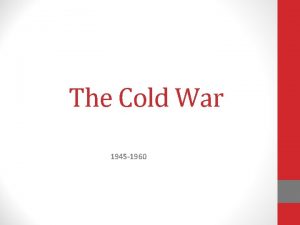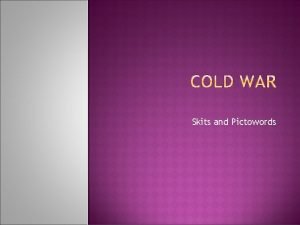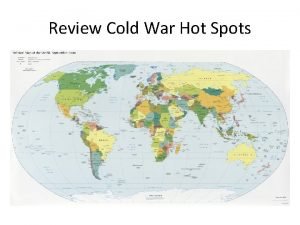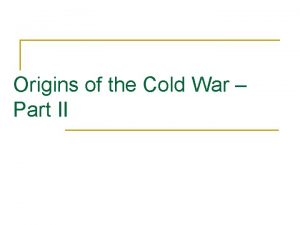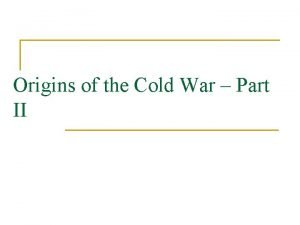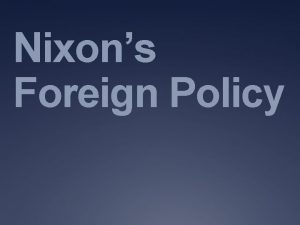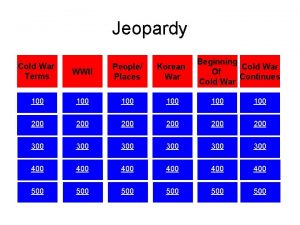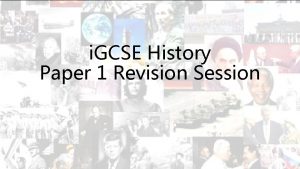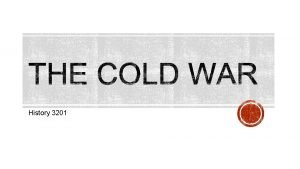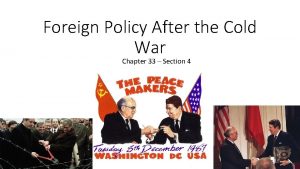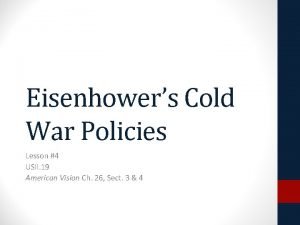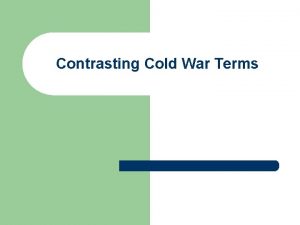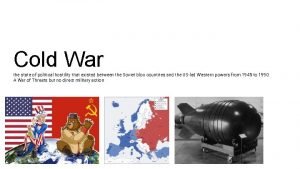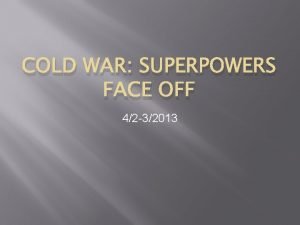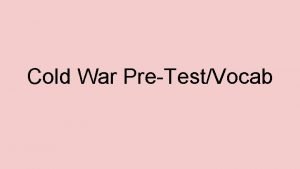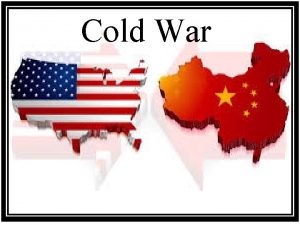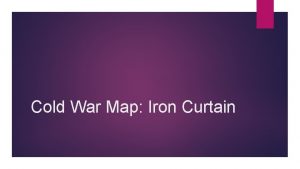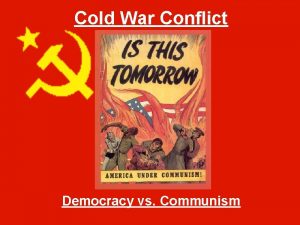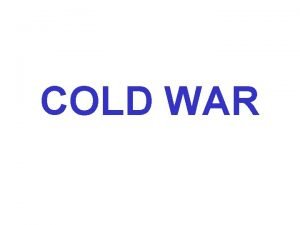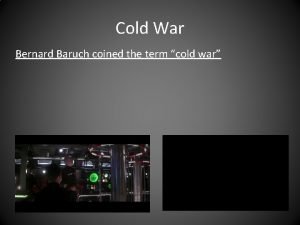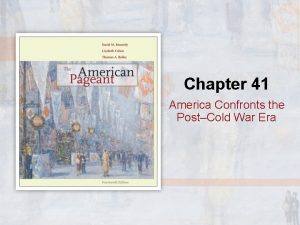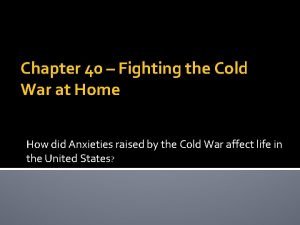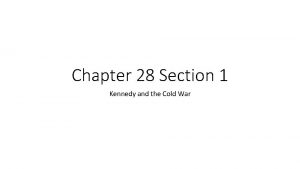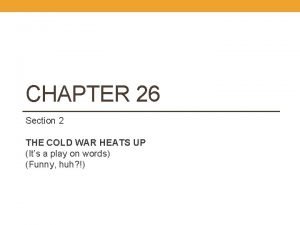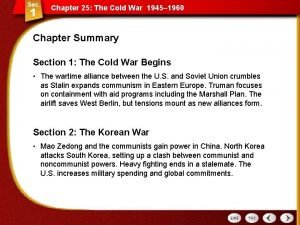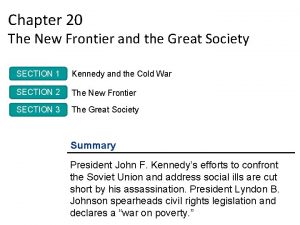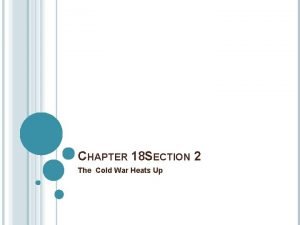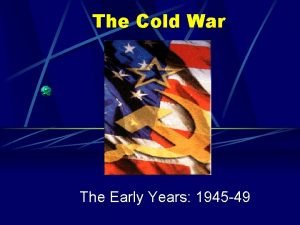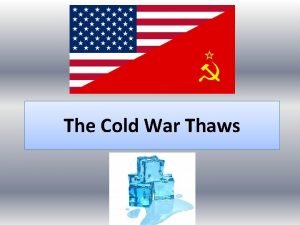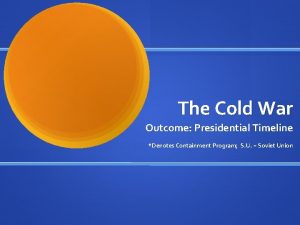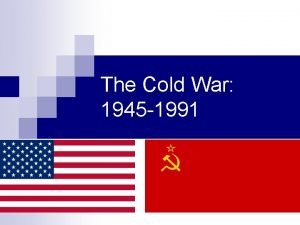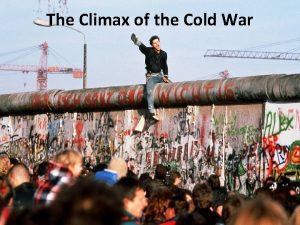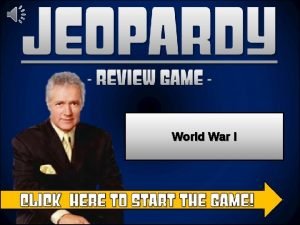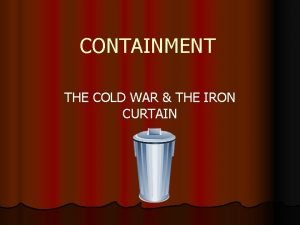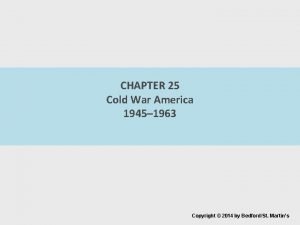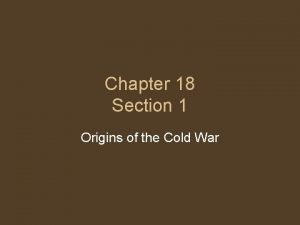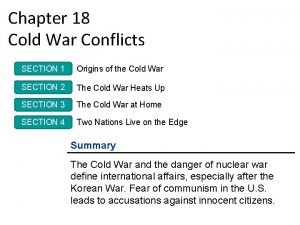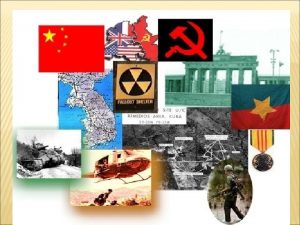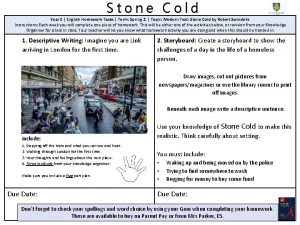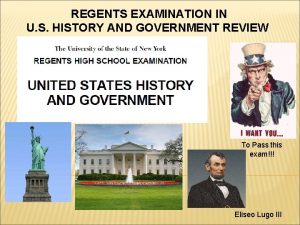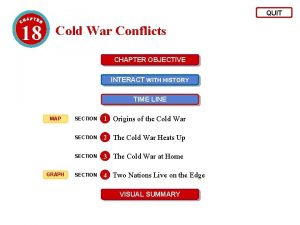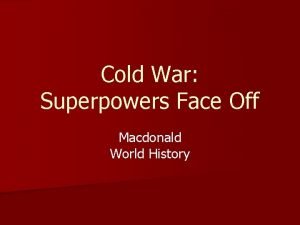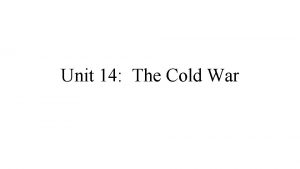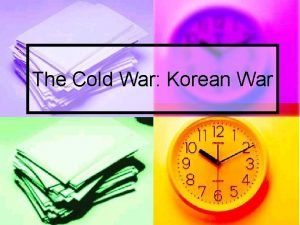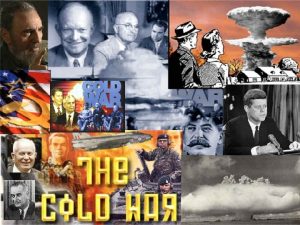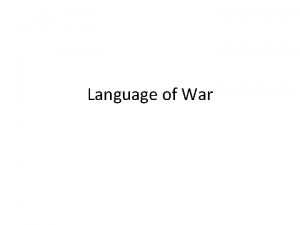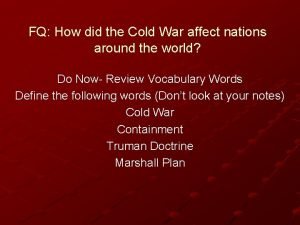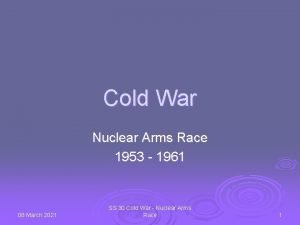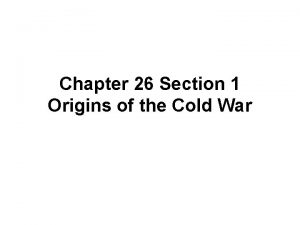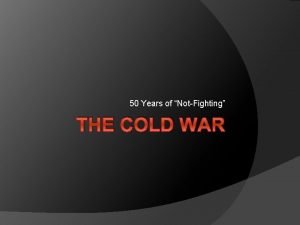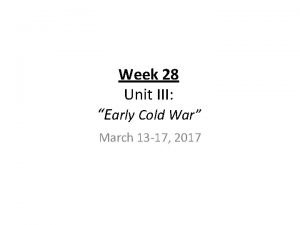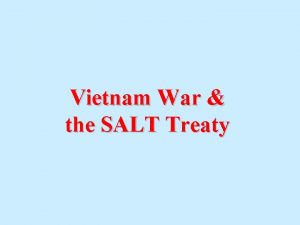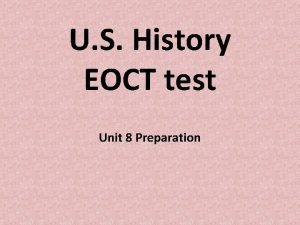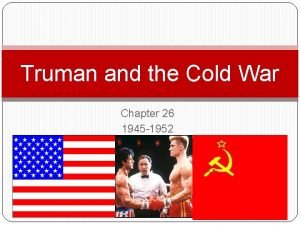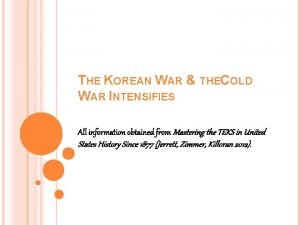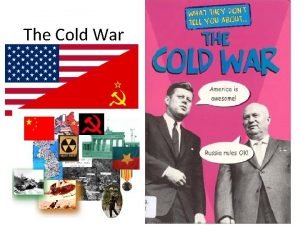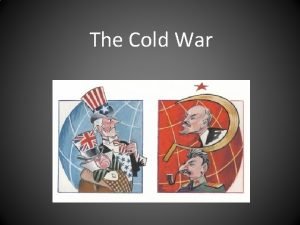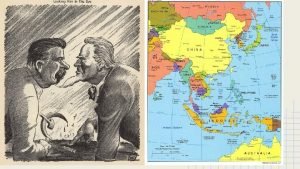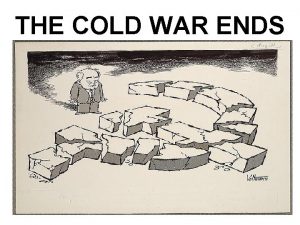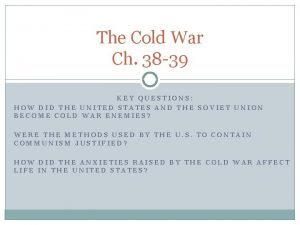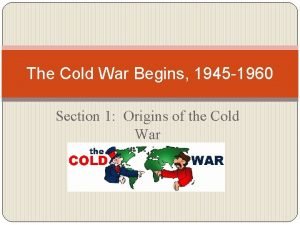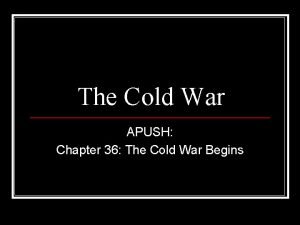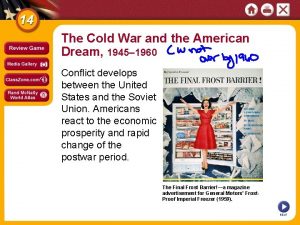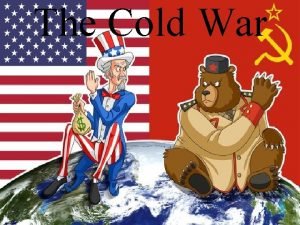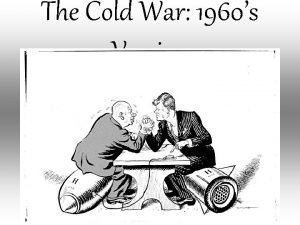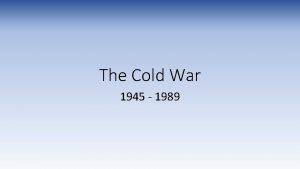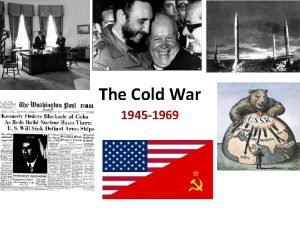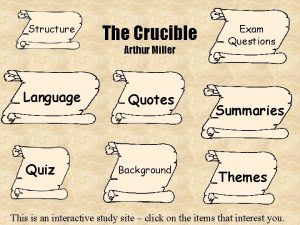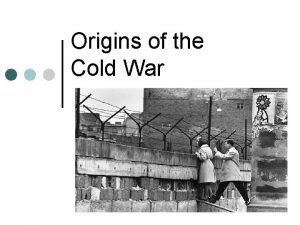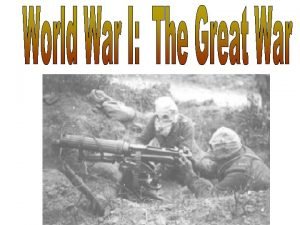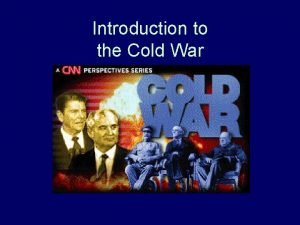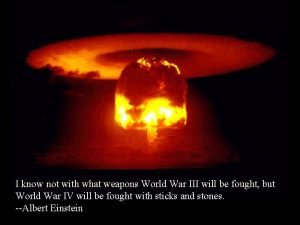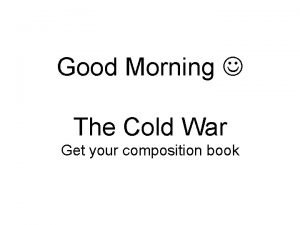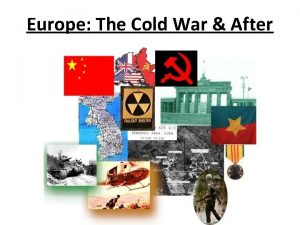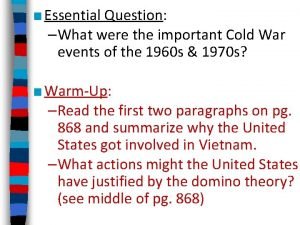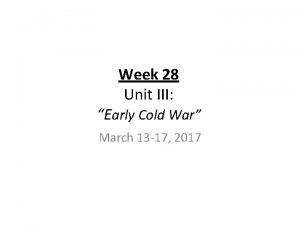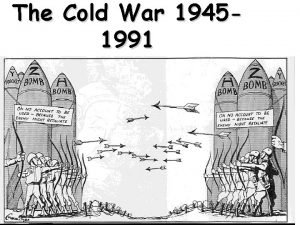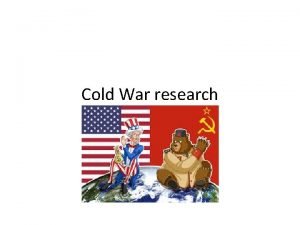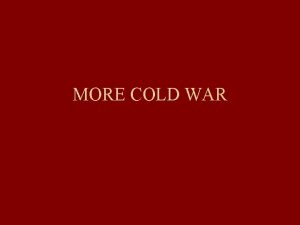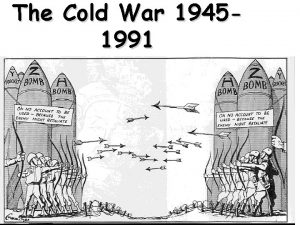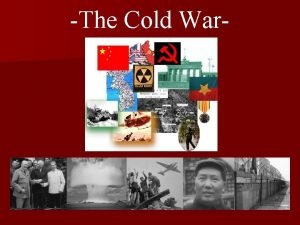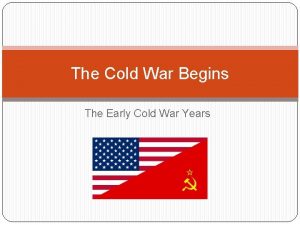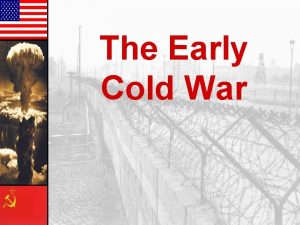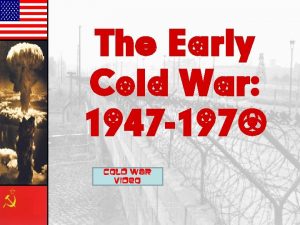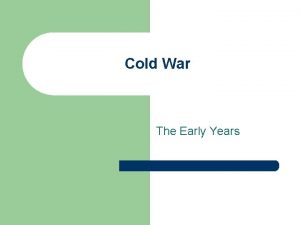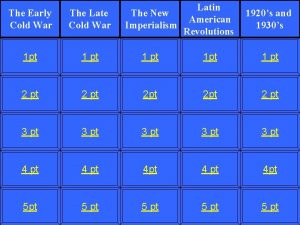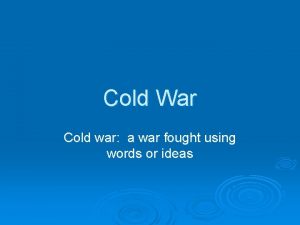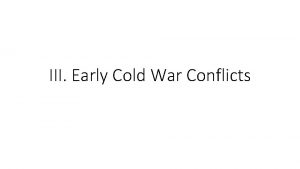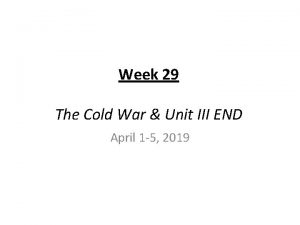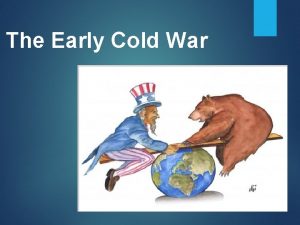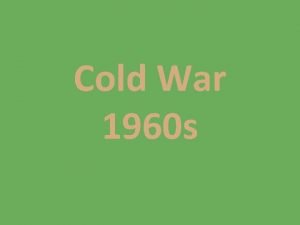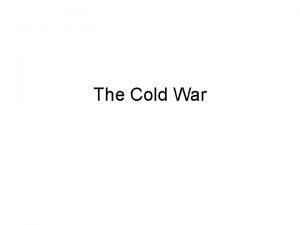Week 28 Unit III Early Cold War March


















































































































- Slides: 114

Week 28 Unit III: “Early Cold War” March 13 -17, 2017

Why are we here this week? Students will complete Post-WW II & early Cold War “ 5 words” PPT slides & terms. Students will analyze and respond in writing to Flow of History Charts #138140. Advanced students will begin reading & analyzing Cold War DBQ documents.

Homework: Complete “ 5 words” Power. Point slide & email mrobinso@cbsd. org as an attachment Finish Post-WW II & early Cold War terms packet by Wed. 3/15 Monday, March 3, 2017 I. GROUP Conversation Piece (3 things) II. Post-WW II & early Cold War COMPLETE “ 5 words” PPT slide(s) Terms packet too! Email mrobinso@cbsd. org Subject: #period 1 (or 2, 3, 4, 6)

World War II & the early Cold War Instead they found their nation locked in a new kind of conflict with the U. S. S. R, or Soviet Union. This "cold war" defined U. S. foreign policy for decades to come. It also raised a troubling question: "How could a free people best balance the ideal of liberty with the need for national security? "

World War II & the early Cold War During this era, the United States was transformed from an isolationist nation into a global Was a global communist superpower. When a war engulfed Asia and Europe in the late 1930 s, most Americans hoped to remain revolution likely, or did the U. S. neutral. A surprise Japanese attack on Pearl Harbor shattered that hope. Once at war, men and women of exaggerate the Soviet threat? all backgrounds joined together to fight a common foe. As World War II came to a close, Americans yearned for peace. Instead they found their nation locked in a new kind of conflict with the U. S. S. R. or Soviet Union. This "cold war" defined U. S. foreign policy for decades to come. It also raised a troubling question: "How could a free people best balance the ideal of liberty with the need for national security? "

Unit III: Essential Questions • When should the United States go to war? • What is required to achieve victory in war? • What impact do challenges abroad have on Americans at home? Have you noticed (started? ) the Unit III study guide? • Did America’s development as a super power move it closer or further away from its founding ideals?

86, 400 https: //www. youtube. com/watch? v=s 2 TH 0 z. Oj 9 d 0 https: //www. youtube. com/watch? v=Ue 8 RSDMZVOQ


Post-WW II & early Cold War THINK, PAIR, SHARE your construction 1. Find partner(s)… Your CHOICE! 2. Examine “resources” and READ pages in textbooks… Did you “do your HW? ” Will you pick a 2 nd or 3 rd term? 3. Select “ 5 words” that demonstrate your term’s meaning in order from least to most obvious Did you follow the TEMPLATE? Share with partner(s)? 4. Prepare two distinct images (one challenging, one obvious) that represent your term. Finish slide(s), email mrobinso@cbsd. org with a copy

Post-WW II & Cold War Terms 1) Find your partner who has the other half of your word(s) or phrase(s) Super N Powers U 2) Locate your words in the both textbooks & confirm pages The Americans History Alive! 3) What are the *5 KEY “WORDS” (not a sentence) related to your term(s) (explanatory “clues, ” synonyms, people, places, events, dates, etc. ) *words are arranged from hardest/most vague (1 st) to easiest/most obvious (5 th) 1) Most difficult CLUE or HINT… 5) Easiest CLUE or HINT 4) What clip art, pictures, cartoons, or other visuals best represent your term(s)? 5) Prepare to SHARE your concepts (Power. Point & verbally)

UN Post-WW II & early Cold War Super Powers Essential terminology Iron Curtain satellite nations 1) Find your partner who has the other half of your word(s) containment Truman and his Doctrine 2) Locate your word in the textbook(s) & confirm page(s) George C. Marshall and his Plan Post-WW II Germany 3) Select 5 KEY WORDS (not a sentence) related to your NATO concept(s) Warsaw Pact What “words” will you choose? China and its Civil War Korean War What images best represent your term? blacklist HUAC & Mc. Carthyism 4) Follow the TEMPLATE and create your SINGLE brinkmanship, H-bomb, and MAD slide…SHARE via email (as attachment, please) CIA 5) Prepare to SHARE your concept(s) through a “live Nikita Khrushchev action” activity (Power. Point analysis & critique) Space Race U-2 incident JFK and the Cuban Missile Crisis

United Nations Americans, p. ; Alive!, p. • 1 st word (hardest clue) • 2 nd word (still challenging) • 3 rd (becoming obvious) • 4 th (second easiest clue) • 5 th (“dead give away” clue) Your INITIALS please

Post-WW II & Cold War Terms “ 5 Words” by Period 1 -4, 6 (2016 -17)

Term or Phrase Americans, p. ; Alive!, p. • 1 st word • 2 nd • 3 rd • 4 th • 5 th (hardest) (challenging) (clear) (easy) (obvious) Your INITIALS

Term or Phrase Americans, p. ; Alive!, p. • 1 st word • 2 nd • 3 rd • 4 th • 5 th (hardest) (challenging) (clear) (easy) (obvious) Your INITIALS

United Nations Americans, p. 603; Alive!, p. 481 • 1945 • Post-Pearl Harbor • 50 nations • UDHR • peacekeeping

United Nations Americans, p. 603; Alive!, p. 481 United Nations (UN) was the international peacekeeping organization to promote peace and economic development. • 1945 • Post-Pearl Harbor • 50 nations originally, 193 of 195 -6 belong today • UDHR: 4 Essential Freedoms speech & expression, worship, from fear & want • peacekeeping

Super Powers Americans, p. 602 -603; 607; Alive!, p. 494 • control • United States • democracy • Soviet Union (USSR) • communism

Super Powers Americans, p. 602 -603; 607 Alive!, p. 494 • US & USSR • democracy & capitalism versus communism • hegemony influence • global competition: space race, military (nukes!), allied nations • control Cold War = political hostility that existed between the Soviet bloc countries and the US-led Western powers from 1945 to 1990. It was a conflict between the Soviet Union and the U. S. without weapons being fired.

Iron Curtain Americans, p. 609; Alive!, p. 496 • barrier • USSR • Churchill • Europe • communism TD, AD

Iron Curtain Americans, p. 605; Alive! 496 -97 • barrier in Europe • communist “East” • capitalist & democratic “West” • Former British Prime Minister Winston Churchill • Berlin Wall marks formal division Iron curtain was a term first used by Winston Churchill to describe the line that separates communism from democracy.

satellite nations Americans, p. 605 ; Alive!, p. 505 • secondary • backup • motherland • USSR • communism

satellite nations Americans, p. 605; Alive!, p. 505 • communism • Eastern Europe • USSR (Stalin) • Iron Curtain • containment Satellite Nations Albania, Bulgaria, Czechoslovakia, Hungary, Romania and Poland. Stalin took control and forced communist rule.

containment Americans, p. 605; 737 ; Alive!, p. 494; 497, 508, 511 • isolation • restriction • anti-expansion • Iron Curtain • communism ER, SA

containment Americans, p. 605; 737 ; Alive!, p. 494; 497, 508, 511 • restriction of Containment blocks communism other countries efforts to spread its influence • anti-expansion of their type of government. • Iron Curtain • US Diplomat in USSR George Kennan • Implemented by President Harry S. Truman

Truman and his Doctrine Americans, p. 606; Alive!, p. 498 • prevention • communism • Europe • aid • president LM, GJ

Truman and his Doctrine Americans, p. 606; Alive!, p. 498 & 501 • • • military & economic aid president’s policy Turkey & Greece ($400 mil. ) containment of communism pro-democracy Truman Doctrine Economic and military aid to nations trying to avoid the threat of the spread of communism.

George Marshall & his Plan Americans, p. 606; Alive!, p. 499 • opposition • reconstruction • general • aid • anti-communism JW, TU

George Marshall & his Plan Americans, p. 606; Alive!, p. 468; 499 -500 • Funds to rebuild Post-WW II Europe • European Recovery Act • hope & stability • Pro-democracy (anti -communism) • Secretary of State, WW II General Marshall Plan Economic aid provided by the U. S. to help rebuild nations after the war & contain communism (1947). Provided help from poverty, chaos, and desperation.

Post-WW II Germany Americans, p. 607; 677; Alive!, p. 482; 504 • communism • aftermath • segregation • East vs. West • Berlin Wall BS, GW

Post-WW II Germany Americans, p. 607; 677; Alive!, p. 504 • aftermath = East (communist) split from West (free) • Allied occupation zones • Berlin Blockade by USSR (June 1948) • Berlin Airlift (June 1948 -May 1949) • Berlin Wall (19611989) • Reunified into one Germany (1990) Berlin Airlift Berlin divided between Allies and the Soviets. Americans airlifted food and supplies until Stalin got rid of the blockade.

NATO Americans, p. 608; Alive!, p. 505 • alliance • treaty • collective security • Warsaw Pact • defense AE, BU

NATO Americans, p. 608; 624; Alive!, p. 505 • defensive alliance • collective security against possible Soviet attack • signed by 12 democratic nations (1949) • Ended isolationism for US (28 members today) • By 1955 500, 000 troops, plus thousands of planes, tanks, etc. in Europe • Countered by Warsaw Pact North Atlantic Treaty Organization Military support to all members if attacked. Started for the fear of Soviet aggression.

Warsaw Pact Americans, p. 624 ; Alive!, p. 505 • NATO • 7 countries • rearmament • communism • alliance AK, EN

Warsaw Pact Americans, p. 624; Alive!, p. 505 • communist alliance (1955) • security agreement • united against NATO • West Germany rearmed & joined NATO • USSR, plus 7 Eastern Warsaw Pact-A European countries pact between the Soviet Union • Dissolved in 1991 collapse of the and their satellite Soviet Union countries for military purposes

China’s Civil War Americans, p. 610 ; Alive!, p. 515 • Nationalists • Taiwan • communism • revolt • Mao Zedong JP, EC

China’s Civil War Americans, p. 609 -610 ; Alive!, p. 507 -508 • China experienced a revolution • Nationalists Chiang. Kai Shek (center) supported by US • Communists Mao Zedong (right) & Red Army supported by the Soviets • People’s Republic of China (communists win in 1949) • Taiwan (Republic of China) democratic/capitalist Chiang Kai-Shek was a Nationalist ruled in southern and eastern China. Got aid from the U. S. Moved to Taiwan. Mao Zedong was the communist leader of Northern China. Financial aid from the Soviets. Peoples Republic of China.

Korean War Americans, p. 611 ; Alive!, p. 508 -509 • DMZ • peninsula • communism • North • South NG, KB

Korean War Americans, p. 609 -615; Alive!, p. 508 -509 • Communists tried General Mac. Arthur American troops led by Mac. Arthur to reunify launched a counterattack taking peninsula (June 25, back the 38 parallel. Mac. Arthur wanted a war against China and 1950) Truman disagreed. He was fired. • United Nations intervenes (90% American forces) • stalemate results in demilitarized zone (to present) • truce line (38 th parallel) th

blacklist Americans, p. 618; Alive!, p. 521 • 500 • fear • communists • Hollywood • tarnished CP

blacklist Americans, p. 618; Alive!, p. 521 • 500 actors, writers, producers, & directors • suspected communists & communist sympathizers • fear & paranoia • Hollywood Ten • tarnished reputations • lost job opportunities Blacklist It happened when 500 people in the movie industry were suspected of being under communist influence. They weren’t allowed to work. Hollywood Ten were witnesses called to testify, but they refused to cooperate regarding possible communist influence in the movie industry. Those witnesses were put in prison.

HUAC & Mc. Carthyism Americans, p. 620 -621 ; Alive!, p. 522 • blacklist • infiltration • anti-communism • loyalty oaths • Hollywood 10 RK, ST

HUAC & Mc. Carthyism Americans, p. 620; Alive!, p. 522 • unsubstantiated attacks • anti-communist Mc. Carthyism-People who were suspected of being communists although there was investigations • suspected communist little or no evidence to support claims. House Un-American Activities Committee sympathizers (HUAC) a committee that investigated communism in the movie industry. • infiltration • propaganda • Senator Joseph Mc. Carthy (R-Wisconsin) • House Un-American Activities Committee • Congressional hearings • loyalty oaths • Produced “flimsy evidence” • unconstitutional

brinkmanship Americans, p. 623 ; Alive!, p. 515 • world • destruction • weapons • edge • “all-out-war” PS, JG

Brinkmanship, H-Bomb, MAD Americans, p. 623 ; Alive!, p. 515 • push to the edge • “all-out-war” • powerful thermonuclear weapons for US (1952) & USSR (1953) • Hydrogen bomb = 1 million tons of TNT… 67 times the power of A-bomb dropped on Hiroshima • Mutually Assured Destruction • world destruction threatened • air raid drills & fallout shelters Brinkmanship when a country threatens another country with massive military aggression. “Going to the brink of war” H-Bomb was more powerful than the atomic bomb. Race with the soviets to see who could develop the H-bomb first. By 1953 both had the bomb. By 1963 a hot line linked the White House to the Kremlin so that communication in a crisis could be made easier.

CIA Americans, p. 623 ; Alive!, p. 498; 511 • Investigation • agents • secretive • Spies • murder JM, ZA

CIA Americans, p. 623 -624; 626; 674 Alive!, p. 498; 511 -513 • • • • Central Intelligence Agency Formed under Truman’s National Security Central Intelligence Agency Act (1947) (CIA) gathered information international organization about the enemies of the U. S. covert (spy) operations CIA gave millions of dollars to the Shah of Iran to return to his anti-USSR (pro-US interests) country so that the Soviets overthrow unfriendly or leftist would not gain control of the oil (communist) governments fields. The Shah returned and Iran, Guatemala, Dominican Republic gave control of fields to western secret cameras, spy planes (U-2), satellite companies. technology Eisenhower relied heavily on reports authorized training of Cuban exiles (1960) Kennedy authorized Bay of Pigs invasion (April 17, 1961) 1, 300 -1, 500 exiles attacked in a botched effort (ineffective airstrikes & strategies) Cuba under Fidel Castro had 25, 000 soldiers and Soviet tanks and jets embarrassing & costly episode ($53 million ransom in food & medical supplies for release of commandos)

Nikita Krushchev Americans, p. ; Alive!, p. 503 1 st word Soviet Union 2 nd De-Stalinization 3 rd U-2 • 4 th Shoe • 5 th Chairman TDD

Nikita Khruschev Americans, p. 626; Alive!, p. 630; 632 -633 • Soviet leader (Premier) from 1958 to 1964 • Responsible for the partial de. Stalinization of the USSR (denounced Stalin's dictatorial rule & cult of personality) • Helped make progress in early Soviet space program & liberalized Soviet domestic policy Nikita Khruschev Leader of the soviet Union who believed that communism and democracy could coexist.

Space Race Americans, p. 626; Alive!, p. 629 • October 4, 1957 • Flopnik • Soviet technology • Neil Armstrong • Sputnik DF, JY

Space Race Americans, p. 626 ; Alive!, p. 629 • • Space Race competition for international world’s first satellite was prestige (USSR vs. USA) sent into Sputnik (October 4, 1957) was space by the 1 st artificial satellite Soviets. A US had “flopnik” & “kaputnik” at year later the U. S. launched first its first st 1 satellite success on January satellite. 31, 1958 NASA: National Aeronautics & Space Administration (1958 Eisenhower) 1 st cosmonaut in space (April 12, 1961) was Yuri Gagarin Alan Sheppard was first US astronaut in space (May 5, 1961 -Freedom 7) Neil Armstrong was 1 st man on the moon (July 20, 1969)

U-2 incident Americans, p. 626 -627 ; Alive!, p. • air • shot • spy • Francis Gary Powers • plane

U-2 incident Americans, p. 627; Alive!, p. 502 -502; 511 • US spy plane • Soviets shoot it down (May 1, 1960) • Francis Gary Powers (US pilot) captured in Soviet territory • Nikita Khruschev (USSR) demanded US apology • Eisenhower refused • US-USSR summit cancelled • great tension between the superpowers U-2 American spy plane shot down in Soviet territory. Caused more tension between Soviet and U. S.

JFK & the Cuban Missile Crisis Americans, p. 674; Alive!, p. 632 • quarantine • USSR • Kennedy • spyplane • nukes KG,

JFK & the Cuban Missile Crisis Americans, p. 674 -676; Alive!, p. 632 -633 • • • Soviets built missile launch sites on Cuba (1962) US president Kennedy calls for quarantine (blockade) of island Soviet leader Nikita Khruschev sent more ships to Cuba Grave nuclear danger for “ 14 days” in October 1962 JFK relied on 12 most trusted advisors (Ex. Com = Executive Committee for National Security) Nikita Khruschev “blinked” and agreed to remove missiles (US pledged NOT to invade Cuba) Cuban Missile Crisis US-Soviet confrontation of missile launch sites discovered by the US in communist Cuba in 1962. It was the closest the Cold War ever came to nuclear war.

Chapter 18: Cold War Conflicts 1. The Cold War was a war without direct the between the U. S. and . It started soon after the end of conflicting because of the two nations’ and systems and their disagreements over the future of .

Chapter 18: Cold War Conflicts 1. The Cold War was a war without direct military confrontation between the U. S. and the Soviet Union (USSR). It started soon after the end of World War II because of the two nations’ conflicting political and economic systems and their disagreements over the future of Europe. Other answers?

Chapter 18: Cold War Conflicts 2. The United States got involved in the Korean War to halt the spread of in Asia by stopping the advance of Korea into Korea.

Chapter 18: Cold War Conflicts 2. The United States got involved in the Korean War to halt the spread of communism in Asia by stopping the Communist advance of North Korea into South Korea. Other answers?

Chapter 18: Cold War Conflicts 3 a. Americans began to fear the influence of communism within their own after the success of Communist takeovers in Europe and . Two spy cases increased this fear: the case of , who was accused of spying for the Soviets, and that of the , who were executed for giving the Soviets secret information about the atom bomb.

Chapter 18: Cold War Conflicts 3. Americans began to fear the influence of communism within their own borders after the success of Communist takeovers in Eastern Europe and China. Two spy cases increased this fear: the case of Alger Hiss, who was accused of spying for the Soviets, and that of the Rosenbergs, who were executed for giving the Soviets secret information about the atom bomb.

Chapter 18: Cold War Conflicts 3 b. Some effects of the fear of communism: the establishment of the Loyalty Review Board to investigate ; ’s investigation of the Hollywood film industry; the passage of the Mc. Carran Act that outlawed the planning of acts against the U. S. government; and Senator ’s unproved accusations against hundreds of government officials. Most of these actions were .

Chapter 18: Cold War Conflicts 3. Some effects of the fear of communism: the establishment of the Loyalty Review Board to investigate government employees; (House Committee on Un-American Activities) HUAC’s investigation of the Hollywood film industry; the passage of the Mc. Carran Act that outlawed the planning of subversive acts against the U. S. government; and Senator Joseph Mc. Carthy’s unproved accusations against hundreds of government officials. Most of these actions were unconstitutional. Other answers?

Chapter 18: Cold War Conflicts 4. Some of the events that increased hostilities between the U. S. and the Soviet Union: the race; creation of ; the and the ’s covert actions in interfering with some foreign governments; the launching of Soviet invasion of ; the ; Soviet threat of missile launch against British, French, and Israelis over seizure of the ; the U-2 incident in which a CIA was brought down over Soviet territory.

Chapter 18: Cold War Conflicts 4. List some events of the 1950 s that increased hostilities between the United States and the Soviet Union. 4. Some of the events that increased hostilities between the U. S. and the Soviet Union: the arms race; creation of NATO and the Warsaw Pact; the (Central Intelligence Agency’s) CIA’s covert actions in interfering with some foreign governments; the launching of Sputnik I; the Soviet invasion of Hungary; Soviet threat of missile launch against British, French, and Israelis over seizure of the Suez Canal; the U-2 incident in which a CIA spy plane was brought down over Soviet territory.

Alive! Ch. 37: The Aftermath of WW II • • • At the end of World War II, the United States vowed not to repeat the mistakes of World War I. With the other Allies, it worked to establish ways of avoiding future conflicts and dealing with war crimes. At home, Congress passed legislation to help returning veterans rejoin postwar society. Four Freedoms In 1941, Franklin Roosevelt expressed the wish that all people should have freedom of speech and expression, freedom of worship, freedom from want, and freedom from fear. These Four Freedoms became part of the charter of the United Nations Before the war was over, 50 nations cooperated to form the United Nations. The United States played a strong role in founding this international organization. The goals of the United Nations include world peace, security, and respect for human rights. Nuremberg War Crimes Trials Instead of punishing all Germans, the Allies held Nazi leaders responsible at the Nuremberg Trials. A similar set of trials brought Japanese leaders to justice. Later, temporary international tribunals, as well as a permanent International Criminal Court, were formed to deal with war criminals. Geneva Conventions To catalog war crimes, many nations of the world met at Geneva, Switzerland, in 1949. The Geneva Conventions prescribed the proper treatment of the wounded, prisoners of war, and civilians. GI Bill of Rights The United States sought to prevent economic and social problems at home after the war. One measure designed to accomplish this goal was the GI Bill of Rights, which provided unemployment benefits, college funds, and housing loans to veterans.

Alive! Ch. 38: Origins of the Cold War • • In the postwar period, clear differences between the United States and the Soviet Union soon emerged. Communist ideology and the creation of Soviet-backed states in Eastern Europe alarmed the U. S. government. The United States responded with efforts to support European democracy and limit Soviet expansion. As the rivalry intensified, Europe divided into communist-controlled Eastern Europe and mostly democratic Western Europe. Yalta and Potsdam Conferences At Yalta, the Allied leaders met to shape postwar Europe. They divided Germany and Berlin into four occupation zones each and declared their support for self-government and free elections in Eastern Europe. At Potsdam, the leaders finalized their postwar plans for Germany. However, the relationship among the superpowers began to weaken. Iron Curtain In a 1946 speech, Winston Churchill accused the Soviet Union of dividing Europe into East and West and drawing an “iron curtain, ” or barrier, across the continent. UN Atomic Energy Commission At the United Nations, the United States offered a plan to limit the development of atomic weapons. The Soviet Union, working on its own atomic bomb, rejected U. S. efforts to retain a monopoly on atomic energy. Truman Doctrine President Truman adopted a policy of containment as part of the Truman Doctrine. The doctrine aimed to limit the spread of communism and support democracy. Marshall Plan This aid program reflected the Truman Doctrine’s goals. It provided aid to European nations to help them recover from the war, promote stability, and limit the appeal of communism. The Soviets responded with the Molotov Plan for Eastern Europe. Cold War The postwar struggle for power between the United States and the Soviet Union became known as the Cold War. Although this was largely a war of words and influence, it threatened to heat up and produce armed conflict between the superpowers.

Alive! Ch. 39: The Cold War Expands • • • During the Cold War, the superpower conflict that began in Europe expanded to China and other parts of the world. The nuclear arms race added to Cold War tensions. Berlin Blockade In 1948, the Soviet Union set up a blockade around Berlin to force the Allies to either abandon the city or cancel plans for the creation of West Germany. The Allies launched an airlift to bring supplies into Berlin and break the blockade. In the end, Germany was split between east and west. NATO and the Warsaw Pact In 1949, the Western powers formed the North Atlantic Treaty Organization as a military alliance to counter Soviet aggression. The Soviets responded by forming their own military alliance, the Warsaw Pact, with Eastern European countries. Korean War After the fall of China to communism, Cold War tensions flared up in Korea. In 1950, North Korean communists invaded South Korea, prompting a war with U. S. and UN forces. The Korean War ended in 1953, but Korea remained divided. Third World During the Cold War, the United States and the Soviet Union tried to win friends and allies in the Third World—the developing nations of Latin America, Africa, and Asia. This battle for “hearts and minds” involved propaganda, aid, covert action, and military intervention. Mutual Assured Destruction The invention of the H-bomb fueled a deadly arms race. In response, the United States developed various policies, including brinkmanship and deterrence, to manage the nuclear threat. In the end, it relied on the policy of Mutual Assured Destruction to limit the chances of all-out war.

Alive! Ch. 40: Fighting the Cold War at Home • Like earlier wars, the Cold War created fright and anxiety on the home front. Fearful of attacks from within, the government sought to root out communist subversion. Faced with the threat of nuclear attack from the Soviet Union, it promoted civil defense and preparedness planning. • House Un-American Activities Committee HUAC investigated the loyalty of people in many areas of life. Its probe of the movie industry led movie studio heads to blacklist anyone thought to be a communist or communist sympathizer. Spy trials Fears of subversion deepened with the Alger Hiss case and the Rosenberg trial. Hiss served a prison term, and the Rosenbergs were executed for selling atomic secrets to the USSR. Mc. Carthyism Senator Joseph Mc. Carthy launched a well-publicized crusade against subversives in government. The term Mc. Carthyism came to refer to personal attacks against innocent people with little or no evidence to support the charges. Atomic Age Americans greeted the Atomic Age with a mixture of fear and excitement. Many people had high hopes for peaceful uses of atomic power. Federal Civil Defense Administration Congress established the FCDA to help Americans survive a nuclear attack. The FCDA published civil defense manuals and promoted drills and other measures to protect Americans from harm. As the power of nuclear weapons increased, however, the usefulness of such precautions came into question. • •

Flow of History Charts #138 -139 -140 • http: //flowofhistory. com/readingsflowcharts/the-world-since-1945/thepost-war-world-1945 -60/fc 138 READ (essays), “ANALYZE, ” annotate, and ANSWER ? s… up to 5 pts EACH http: //flowofhistory. com/readingsflowcharts/the-world-since-1945/thepost-war-world-1945 -60/fc 139 http: //flowofhistory. com/readingsflowcharts/the-world-since-1945/thepost-war-world-1945 -60/fc 140

What “ignited” the Cold War? Explain at least TWO SPECIFIC THINGS that contributed to Post. WW II tensions between the US and the USSR. How many causes? What was the “root cause? ” Describe the new “balance of power. ” CLICK hyperlinks to READ about Flow of History http: //www. flowofhistory. com/r eadings-flowcharts/the-worldsince-1945/the-post-war-world 1945 -60/fc 138

How do you “fight” a Cold War? Describe thought process on how to “win” without starting WW III? http: //www. flowofhist ory. com/readingsflowcharts/the-worldsince-1945/the-postwar-world-194560/fc 139

How do events in Europe and Asia compare during the early years of the Cold War? http: //www. fl owofhistory. co m/readingsflowcharts/the -world-since 1945/the-postwar-world 1945 -60/fc 140 Explain at least TWO SPECIFIC THINGS that illustrate how the conflict was DIFFERENT in Europe compared to ASIA How many “packet terms” are in this flowchart?

Watch and/or use chapter NOTES to RECORD details for Chapters 1 -9. The United States and the Soviet Union emerged from World War II at odds over their postwar goals. The escalation of these conflicting opinions led the world into a tense, bitter struggle that came to be known as the Cold War. While the world's superpowers never battled each other directly, their indirect involvement with each other in locales around the globe pushed the world to the brink of nuclear war. This vivid program utilizes archival footage and interviews with renowned experts to dramatize this uneasy period in American history, featuring in-depth coverage of the crisis in Berlin, Fidel Castro and Cuba and the eventual fall of the Soviet Union.

The Cold War Safari Montage At the end of World War II, the United States and the Soviet Union emerged as the world’s dominant superpowers. Allies during the war, the two sides had conflicting post-war goals. The U. S. wanted to extend its principles of democracy and capitalism throughout war-weary Europe and developing Third World countries, while the Soviet Union was interested in surrounding itself with a buffer zone of Communist nations in Eastern Europe, as well as supporting Communist movements throughout the world. The resulting ideological clash between the two superpowers led to a tense, bitter competition for the next 50 years, known as the Cold War. While the United States and Soviet Union never went to war directly, they battled indirectly in various locations throughout the world. In an attempt to contain Soviet expansion, U. S. troops were sent to Korea in 1950 to drive Communist forces from the South. Although this struggle ended in a stalemate, the U. S. and its allies showed that they were willing to fight to prevent Communist expansion.

The Cold War (CONT’D) A particularly dangerous aspect of the Cold War was the nuclear arms race, and the world faced a possible nuclear catastrophe in 1962 during the Cuban Missile Crisis. After a period of détente during the Nixon and Carter administrations, the Soviet invasion of Afghanistan in 1979 escalated Cold War tensions, and President Ronald Reagan made defeating communism the cornerstone of his foreign policy. Increased military spending during the Reagan years is credited with hastening the collapse of the Soviet Union, as the Soviet economy was unable to match the U. S. military build-up. U. S. military might, combined with Soviet leader Mikhail Gorbachev’s policy of political openness, stirred the people of Eastern Europe to end Communist regimes, and by the end of 1993, the Cold War was over. The rapid collapse of the Soviet Union and the sudden end of the Cold War left the United States and Western Europe scrambling to reshape a new world in which democracy and capitalism could flourish.

Cold War Timeline 1945 — World War II ends. 1946 — The Soviet Union begins to dominate the countries of Eastern Europe. 1948 — The United States implements the Marshall Plan. 1948 — The United States begins the Berlin Airlift. 1949 — NATO is formed. 1950 — The Korean War begins. 1955 — The Warsaw Pact is formed. 1957 — The Soviet Union launches Sputnik. 1958 — NASA is created. 1960 — The Soviet Union shoots down an American U 2 spy plane. 1961 — The Berlin Wall is erected. 1961 — The United States sends its first military personnel to Vietnam. 1962 — The Cuban Missile Crisis. 1963 — President Kennedy is assassinated in Dallas, Texas, on Nov. 22 nd. 1972 — President Nixon makes an unprecedented trip to Communist China. 1972 — SALT I treaty with the Soviet Union is completed.

Cold War Vocabulary Third World — The group of developing countries in the world not linked with the United States or the Soviet Union during the Cold War. capitalism — An economic system characterized by private ownership of property and free enterprise. communism — An economic system in which all goods are owned jointly; in the Soviet Union, this developed into a government in which all social and economic policy decisions were made by a single party. Cold War — An intense hostile rivalry during the second half of the 20 th century between Communist nations, particularly the Soviet Union, and the democratic nations of the world, led by the United States. containment — The foreign policy of the United Sates designed to stop the growth of communism. Iron Curtain — An imaginary line that separated the countries in Western Europe from the countries under Soviet domination in Eastern Europe. Truman Doctrine — A 1947 pronouncement by President Truman that offered aid to the governments of Greece and Turkey in their fight against Soviet influence; the first application of the containment policy. Marshall Plan — A program implemented by the United States in 1948 to help bolster the economies of European countries trying to recover after World War II. blockade — A military strategy that attempts to isolate a country by preventing the movement of its people and goods. North Atlantic Treaty Organization (NATO) — A mutual defense alliance established in 1949 between the United States, Canada and several Western European countries designed to safeguard Western Europe against Soviet attack. Warsaw Pact — A mutual defense organization established in 1955 by the Soviet Union and several Eastern European countries. nuclear arms race — The development and warehousing of weapons of mass destruction by the U. S. and the Soviet Union.

Cold War Vocabulary Sputnik- A Russian space satellite launched in 1957 that caused the United States to reassess its role as a world leader in technology and develop its own space agency. Berlin Wall — A barrier surrounding the German city of West Berlin, constructed by the Soviet Union in 1961 to stop people from fleeing Communist East Berlin. Central Intelligence Agency (CIA) — An organization in the United States responsible for gathering information and facilitating overseas communications. Bay of Pigs — An unsuccessful attempt by U. S. -backed Cuban exiles to overthrow Communist Cuban leader Fidel Castro in April 1961. domino theory — The fear that the spread of communism would run rampant among neighboring countries if one were to fall under Communist influence. détente — The relaxation of tensions between nations. Strategic Arms Limitation Treaty (SALT I) — Agreement between the United States and Soviet Union intended to limit the proliferation of long-range nuclear weapons. Contra — A member of a military group that fought the Sandinista government in Nicaragua. Strategic Defense Initiative (SDI) — A program proposed by President Reagan in 1983 that was intended to provide the United States with a space-based defense system to guard against possible nuclear attacks. Intermediate Nuclear Force Treaty (INF) — An agreement signed by President Reagan and Soviet President Gorbachev in 1987 that called for the elimination of medium-range nuclear weapons. glasnost — A policy of political openness in Soviet society instituted by leader Mikhail Gorbachev. perestroika — The restructuring of the failing Soviet economy, allowing for limited free enterprise under Mikhail Gorbachev.

The Cold War Safari Montage














Homework: Complete “ 5 words” Power. Point slide & email mrobinso@cbsd. org as an attachment; finish Post-WW II & early Cold War terms packet by Wednesday Tuesday-Wednesday, March 14 -15, 2017 Snow:

HW: Read FC 138 & answer questions (annotate chart) ADV/1, 3, 6: DBQ Document A Thursday, March 16, 2017 Complete “ 5 words” PPT slide(s) & email mrobinso@cbsd. org w/ copy Finish Post-WW II & early Cold War terms packet Flow of History Chart #138 Adv/1, 3, 6: DBQ Document A

HW: Ch. 37 -40 summary notes & FC 139 due Tuesday ADV/1, 3, 6: DBQ document analysis (B-C+) Friday, March 17, 2017 3/17: Who started the Cold War and WHY? I. Discuss: Cold War Origins II. Progress Check & WORK Time Post-WW II & Cold War terms? Flow of History #138? Adv. Document A analysis? HA summaries 37 -40? FC 139 -140; DBQ III. Practice: 5 WORDS

Chapter 18: Cold War Conflicts 1. The Cold War was a war without direct the between the U. S. and . It started soon after the end of conflicting because of the two nations’ and systems and their disagreements over the future of .

Chapter 18: Cold War Conflicts 1. The Cold War was a war without direct military confrontation between the U. S. and the Soviet Union (USSR). It started soon after the end of World War II because of the two nations’ conflicting political and economic systems and their disagreements over the future of Europe. Other answers?

Phase 3 of Unit III: early Cold War Ch. 18: Cold War Conflicts “ttt”… 10 points (3/9 -3/10) Post-WW II & Cold War Terms Due TODAY! “ 5 words PPT” Prepare to SHARE next week! History Alive! Ch. 37 -40 summary notes (due Tuesday, 3/21*) Flow of History Charts 138, 139*, & 140 Safari Montage video…chapter notes Advanced: Cold War DBQ packet… 10 documents Continue to read analyze Documents B-C+ as directed

Advanced 9 th Grade US History Document-Based Question Early Cold War Question: Some historians argue that the United States exaggerated the threat of communism, while others argue that American containment prevented a global communist revolution. Utilize the documents below to defend either of these two arguments. Requirements: Demonstrate knowledge acquired in class, through homework and from outside sources. Use as many of the documents included with this DBQ as you can. Write clearly and use proper language. Make sure your thesis is clear. Use historical examples to support your generalizations. Your response should fully address the prompt and support thesis. READ and ANALYZE the following documents in search of the following: 1) “message: ” What does this source indicate about the nature of the Cold War? Does the CONTENT reveal that the U. S. acted appropriately or inappropriately? Does the CONTENT show that the U. S. S. R. was a real threat or exaggerated threat? 2) “usage: ” How can you use this document’s message(s) to show that the U. S. acted appropriately or inappropriately during the Cold War? What message(s) support you OPINION that the U. S. needed to stop a global communist takeover OR that it overreacted to the Soviet Union?

Document A Franklin Delano Roosevelt to Ambassador to USSR, William C. Bullitt 1943 Who are the people involved? William C. Bullitt, "How We Won the War and Lost the Peace, " Life, August 30, 1958, p. 94. What kind of communication is this? Setting the stage for the debates over Soviet intentions at the Yalta Conference in 1945, William C. Bullitt, a former ambassador to the USSR and to France, submitted a memorandum to Roosevelt in August 1943 in which he suggested obtaining Stalin's pledge for a renunciation of conquest in Europe and recommended a military advance from the south through Eastern and Central Europe. FDR, who felt he could "handle" Stalin, responded: What historical concepts & vocabulary words must I “know” or research in order to UNDERSTAND this document? “I just have a hunch that Stalin. . . doesn't want anything but security for his country, and I think that if I give him everything I possibly can and ask nothing from him in return, noblesse oblige, he wouldn't try to annex anything and will work with us for a world of democracy and peace. ” How can you use this document to respond to the DBQ question? • Does it show the view that America acted appropriately and prevented a communist takeover? Does it show that America overreacted in the face of the communist threat? Can it be used by both sides of the argument? EXPLAIN

Post-WW II & early Cold War THINK, PAIR, SHARE your construction 1. Find partner(s)… 2. Examine “resources” and READ pages in textbooks… 3. Select “ 5 words” that demonstrate your term’s meaning in order from least to most obvious 4. Prepare two distinct images (one challenging, one obvious) that represent your term.

Advanced 9 th Grade US History Document-Based Question Early Cold War Question: Some historians argue that the United States exaggerated the threat of communism, while others argue that American containment prevented a global communist revolution. Utilize the documents below to defend either of these two arguments. Requirements: Demonstrate knowledge acquired in class, through homework and from outside sources. Use as many of the documents included with this DBQ as you can. Write clearly and use proper language. Make sure your thesis is clear. Use historical examples to support your generalizations. Your response should fully address the prompt and support thesis. READ and ANALYZE the following documents in search of the following: 1) “message: ” What does this source indicate about the nature of the Cold War? Does the CONTENT reveal that the U. S. acted appropriately or inappropriately? Does the CONTENT show that the U. S. S. R. was a real threat or exaggerated threat? 2) “usage: ” How can you use this document’s message(s) to show that the U. S. acted appropriately or inappropriately during the Cold War? What message(s) support you OPINION that the U. S. needed to stop a global communist takeover OR that it overreacted to the Soviet Union?

Document A Franklin Delano Roosevelt to Ambassador to USSR, William C. Bullitt 1943 Who are the people involved? William C. Bullitt, "How We Won the War and Lost the Peace, " Life, August 30, 1958, p. 94. What kind of communication is this? Setting the stage for the debates over Soviet intentions at the Yalta Conference in 1945, William C. Bullitt, a former ambassador to the USSR and to France, submitted a memorandum to Roosevelt in August 1943 in which he suggested obtaining Stalin's pledge for a renunciation of conquest in Europe and recommended a military advance from the south through Eastern and Central Europe. FDR, who felt he could "handle" Stalin, responded: What historical concepts & vocabulary words must I “know” or research in order to UNDERSTAND this document? “I just have a hunch that Stalin. . . doesn't want anything but security for his country, and I think that if I give him everything I possibly can and ask nothing from him in return, noblesse oblige, he wouldn't try to annex anything and will work with us for a world of democracy and peace. ” How can you use this document to respond to the DBQ question? • Does it show the view that America acted appropriately and prevented a communist takeover? Does it show that America overreacted in the face of the communist threat? Can it be used by both sides of the argument? EXPLAIN

Document B Henry Luce, The American Century, 1941 "The American Century" by Henry R. Luce. Life magazine, Feb. 17, 1941. © 1941 Time, Inc. • Henry R. Luce was the founder and publisher of the magazines Time, Life, Fortune, and later Sports Illustrated. "The American Century" appeared in Life magazine just before the bombing of Pearl Harbor and America's official entry into World War II. It's most famous passages presage the internationalism of the post-war period. In the field of national policy, the fundamental trouble with America has been, and is, that whereas their nation became in the 20 th Century the most powerful and the most vital nation in the world, nevertheless Americans were unable to accommodate themselves spiritually and practically to that fact. Hence they have failed to play their part as a world power–a failure which has had disastrous consequences for themselves and for all mankind. And the cue is this: to accept wholeheartedly our duty and our opportunity as the most powerful and vital nation in the world and in consequence to exert upon the world the full impact of our influence, for such purposes as we see fit and by such means as we see fit… As America enters dynamically upon the world scene, we need most of all to seek and to bring forth a vision of America as a world power which is authentically American and which can inspire us to live and work and fight with vigor and enthusiasm… But all this is not enough. All this will fail and none of it will happen unless our vision of America as a world power includes a passionate devotion to great American ideals. We have some things in this country which are infinitely precious and especially American–a love of freedom, a feeling for the equality of opportunity, a tradition of self-reliance and independence and also of co-operation. In addition to ideals and notions which are especially American, we are the inheritors of all the great principles of Western civilization–above all Justice, the love of Truth, the ideal of Charity…It now becomes our time to be the powerhouse from which the ideals spread throughout the world and do their mysterious work of lifting the life of mankind from the level of the beasts to what the Psalmist called a little lower than the angels.

Document C Winston S. Churchill, The Iron Curtain Speech, Fulton, Missouri 1945 From the Congressional Record, 79 th Cong. , 2 nd sess. , 1945 -46, 92: A 1145 -47 • Winston S. Churchill was no longer British Prime Minister on March 5, 1946, when he made his frank " iron curtain" speech in Fulton, Missouri. While attracted to his candid anti-Soviet language, some critics pointed out that in condemning Russia for its influence in Eastern Europe, Churchill ignored British predominance in Greece and the empire. For some observers, Truman's presence on the platform signified American endorsement of Churchill's remarks. From Stettin in the Baltic to Trieste in the Adriatic, an iron curtain has descended across the Continent. Behind that line lie all the capitals of the ancient states of Central and Eastern Europe. Warsaw, Berlin, Prague, Budapest, Belgrade, Bucharest and Sofia, all these famous cities and the populations around them lie in what I must call the Soviet sphere, and all are subject in one form or another, not only to Soviet influence but to a very high and, in many cases, increasing measure of control from Moscow. . If now the Soviet Government tries, by separate action, to build up a pro-Communist Germany in their areas, this will cause new serious difficulties in the British and American zones, and will give the defeated Germans the power of putting themselves up to auction between the Soviets and Western Democracies. Whatever conclusions may be drawn from these facts -- and facts they are - this is certainly not the liberated Europe we fought to build up. .

Document D George E Kennan, The Long Telegram, 1946 Excerpted from U. S. Department of State, Foreign Relations of the United States, 1946 (Washington, D. C. , 1969), 6: 697 -99, and 701 -9. A diplomat in the U. S. Embassy in Moscow and a leading expert on Soviet affairs, George E Kennan sent a long, 8, 000 -word, secret telegram to the State Department early in 1946 sketching the roots of Soviet policy and warning of serious difficulties with the Soviet Union in the years ahead. The stilted language is the product of dropped words to shorten the telegram. Kennan recommended a long-term, firm policy of resistance by the United States to Soviet expansionism, known as "containment. " At bottom of Kremlin's neurotic view of world affairs is traditional and instinctive Russian sense of insecurity…[T]hey have learned to seek security only in patient but deadly struggle for total destruction of rival power, never in compacts and compromises with it… Agencies utilized [by the Soviet Union] for promulgation of policies on this plane are following: Inner central core of Communist Parties in other countries. . . tightly coordinated and directed by Moscow. . Rank and file of Communist Parties… National associations or bodies which can be dominated or influenced…These include: labor unions, Youth leagues, women's organizations, racial societies, religious societies, social organizations, cultural groups, liberal magazines, publishing houses, etc. International organizations which can be similarly penetrated through influence over various national components. Labor, youth and women's organizations are prominent among them. . . In summary, we have here a political force committed fanatically to the belief that with US there can be no permanent modus vivendi, that it is desirable and necessary that the internal harmony of our society be disrupted, our traditional way of life be destroyed, the international authority of our state be broken, if Soviet power is to be secure… Problem of how to cope with this force [is] undoubtedly greatest task our diplomacy has ever faced and probably greatest it will ever have to face. . I would like to record my conviction that problem is within our power to solve and that without recourse to any general military conflict. •

Document E • Harry Truman, Truman Doctrine Speech, 1947 In 1947 the democratic government of Greece was threatened by communist guerrillas believed to be receiving support from the Soviet Union. Facing financial problems and the decline of its empire, the British announced that they could no longer offer support to Greece and Turkey. Americans feared that this would leave Greece and perhaps Turkey open to Soviet domination. The Soviet Union had already taken steps to install communist governments in Poland, Rumania and Bulgaria — seemingly in violation of the Yalta Agreement which had called for free elections in these nations. In this speech Truman asked Congress for $400 million to aid Greece and Turkey, asserting that it was the policy of the United States to "support free peoples who are resisting attempted subjugation by armed minorities or by outside pressures. " At the present moment in world history nearly every nation must choose between alternative ways of life. The choice is too often not a free one. One way of life is based upon the will of the majority, and is distinguished by free institutions, representative government, free elections, guarantees of individual liberty, freedom of speech and religion, and freedom from political oppression. The second way of life is based upon the will of a minority forcibly imposed upon the majority. It relies upon terror and oppression, a controlled press and radio, fixed elections, and the suppression of personal freedoms. I believe that it must be the policy of the United States to support free peoples who are resisting attempted subjugation by armed minorities or by outside pressures. I believe that we must assist free peoples to work out their own destinies in their own way. I believe that our help should be primarily through economic stability and orderly political process

Document F HUAC Interrogates Screenwriter Sam Ornitz, 1947 The Newshour With Jim Lehrer, Excerpt from Seeing Red, October 24, 1997 Excerpted from the PBS documentary "The Legacy of the Hollywood Blacklist" http: //www. pbs. org/newshour/bb/entertainment/july-dec 97/blacklist_10 -24. html The House Un-American Activities Committee (HUAC) existed on a temporary basis beginning in 1938 and became a permanent committee in 1945. HUAC is most widely known for its investigations of suspected Communist influence in the late 1940 s and early 1950 s, the most wellknown investigation being of State Department official Alger Hiss. In September 1947, HUAC subpoenaed 41 witnesses for its hearings on Communist influence in Hollywood. The ten unfriendly witnesses, known as the "Hollywood Ten, " who eventually came to the hearings in October 1947 became the most famous participants in the HUAC hearings. HUAC's initial investigations of Communists in Hollywood ended after the testimony of the Hollywood Ten. The committee resumed investigations of Communist influence on movies in the early 1950 s and continued them for several years. The following interrogation of screenwriter Sam Ornitz is an example of the methods used by the committee and the responses from witnesses who refused to "names. " SPOKESMAN: Are you a member of the Screen Writers Guild? SAM ORNITZ, Screenwriter: I wish to reply to that question by saying that this involves a serious question of conscience. SPOKESMAN: Conscience? SAM ORNITZ: Conscience. I say you do raise a serious question of conscience for me when you ask me to act in concert with you to override the Constitution-- SPOKESMAN: Mr. Chairman. SAM ORNITZ: Wait a minute -- asking me to violate the constitutional guarantee of- SPOKESMAN: Typical communist subversion. The witness is through. Stand away •

Document G Joseph Mc. Carthy, "Speech at Wheeling West Virginia, " 1950 Congressional Record, 81 Cong. , 2 Sess. , pp. 1952 -57 http: //www. turnerlearning. com/cnn/coldwar/reds_re 3. html When the junior Senator from Wisconsin spoke before the Ohio Country Women’s Republican Club in Wheeling, West Virginia in February 1950 he claimed to have a list of 205 communists who worked in the U. S. State Department, shaping American foreign policy. He repeated the speech with minor changes, and placed it in the congressional record. Though Mc. Carthy’s numbers would fluctuate, the charges would propel him to the forefront of American politics. Today we are engaged in a final, all-out battle between communistic atheism and Christianity. . And, ladies and gentlemen, the chips are down — they are truly down. . Six years ago. . . there was within the Soviet orbit 180 million people. Lined up on the antitotalitarian side there were in the world at that time roughly 1. 625 billion people. Today, only six years later, there are 800 million people under the absolute domination of Soviet Russia — an increase of over 400 percent. On our side the figure has shrunk to around 500 million. In other words, in less than six years the odds have changed from 9 to 1 in our favor to 8 to 5 against us. This indicates the swiftness of the tempo of communist victories and American defeats in the cold war. As one of our outstanding historical figures once said, "When a great democracy is destroyed, it will not be because of enemies from without, but rather because of enemies from within. ". . . •

Document H 8 a National Security Council , NSC-68: United States Objectives and Programs for National Security , April 14, 1950 http: //www. fas. org/irp/offdocs/nsc-hst/nsc-68. htm In this memo that would have a significant impact on American policy, the president’s national security advisors depict the threat the U. S. S. R. poses to American interests and what will be required of the United States in its conflict with Soviet Union. [T]he Soviet Union, unlike previous aspirants to hegemony, is animated by a new fanatic faith, antithetical to our own, and seeks to impose its absolute authority over the rest of the world. Conflict has, therefore, become endemic and is waged, on the part of the Soviet Union, by violent and non-violent methods in accordance with the dictates of expediency. With the development of increasingly terrifying weapons of mass destruction, every individual faces the ever-present possibility of annihilation should the conflict enter the phase of total war. Our overall policy at the present time may be described as one designed to foster a world environment in which the American system can survive and flourish…This broad intention embraces two subsidiary policies. One is a policy. . . of attempting to develop a healthy international community. The other is the policy of "containing" the Soviet system. The two policies are closely interrelated and interact on one another. A comprehensive and decisive program to win the peace and frustrate the Kremlin design should be so designed that it can be sustained for as long as necessary. . It would probably involve: A substantial increase in expenditures for military purposes. . •

Document H 8 b (CONTINUED) National Security Council , NSC-68: United States Objectives and Programs for National Security , April 14, 1950 http: //www. fas. org/irp/offdocs/nsc-hst/nsc-68. htm A comprehensive and decisive program to win the peace and frustrate the Kremlin design should be so designed that it can be sustained for as long as necessary. . It would probably involve: A substantial increase in expenditures for military purposes. . A substantial increase in military assistance programs. . . [to meet] the requirements of our allies. . Some increase in economic assistance programs [for our allies]. . Development of programs designed to build and maintain confidence among other peoples in our strength and resolution. . Intensification of affirmative and timely measures and operations by covert means in the fields of economic warfare and political and psychological warfare with a view to fomenting and supporting unrest and revolt in selected strategic. . . countries. Development of internal security and civilian defense programs. Improvement and intensification of intelligence activities Reduction of Federal expenditures for purposes other than defense and foreign assistance. . Increased taxes. . The whole success of the proposed program hangs ultimately on recognition by this Government, the American people, and all free peoples, that the cold war is in fact a real war in which the survival of the free world is at stake.

Document I J. Weston Walch, DBQ 22: The Cold War Begins. 1999. Scott Sagan, “The Evolution of U. S Nuclear Doctrine, ” Published in Moving Targets (Princeton University) The arms race was an important part of the Cold War. Both superpowers developed technology and used their nuclear power to build as many weapons as possible. This nuclear buildup led to a "balance of terror, " which some saw as a deterrent to war. But others feared the use of these weapons. The chart below shows the number of nuclear warheads during the Cold War. .

Document J • Illingworth, Leslie. “The Beginning of the Cold War. ” The Daily Mail, June 16, 1947 http: //www. cartoons. ac. uk/record/ILW 1262 British Cartoonist, Leslie Illingworth illustrates in the British newspaper, The Daily Mail, the potential influence and potential future goals of Josef Stalin upon Europe. Many individuals questioned the position of the western powers in aiding or preventing this potential expansion. The Beginning of the Cold War
 The cold war lesson 1 the cold war begins
The cold war lesson 1 the cold war begins March march dabrowski
March march dabrowski Proxy wars cold war
Proxy wars cold war Unit 8: summarizing the cold war
Unit 8: summarizing the cold war Welcome to our english class
Welcome to our english class Civil war map sherman's march to the sea
Civil war map sherman's march to the sea Hamlet act iii scene ii
Hamlet act iii scene ii Week by week plans for documenting children's development
Week by week plans for documenting children's development Brigance inventory of early development iii
Brigance inventory of early development iii Brigance test for 3 year old
Brigance test for 3 year old 1 week darkening areola early pregnancy pictures
1 week darkening areola early pregnancy pictures Hyde amendment
Hyde amendment Early cpr and early defibrillation can: *
Early cpr and early defibrillation can: * Acrostic poem for cold war
Acrostic poem for cold war Operation rolling thunder cold war
Operation rolling thunder cold war Cold war
Cold war Iron curtain caricature
Iron curtain caricature Operation rolling thunder cold war
Operation rolling thunder cold war The causes of cold war
The causes of cold war Who fought in the cold war
Who fought in the cold war U2
U2 Superpowers cold war
Superpowers cold war Cold war crash course
Cold war crash course What were the characteristics of the cold war?
What were the characteristics of the cold war? Mafia hula hoops cold war
Mafia hula hoops cold war Lesson quiz 18-1 the cold war
Lesson quiz 18-1 the cold war When was the cold war at its height
When was the cold war at its height Who was involved in the cold war
Who was involved in the cold war Neutral countries in cold war
Neutral countries in cold war 2 sides of cold war
2 sides of cold war Causes of the space race
Causes of the space race Pictoword for democracy
Pictoword for democracy Cold war hot spots
Cold war hot spots Origins of the cold war
Origins of the cold war Origins of the cold war
Origins of the cold war Nixons vietnamization policy
Nixons vietnamization policy How did the cold war begin
How did the cold war begin Agent orange and napalm
Agent orange and napalm The cold war
The cold war Chapter 33 section 4 foreign policy after the cold war
Chapter 33 section 4 foreign policy after the cold war Lesson 4 eisenhowers cold war policies
Lesson 4 eisenhowers cold war policies Contrasting cold war terms
Contrasting cold war terms Warsaw pact definition cold war
Warsaw pact definition cold war Chapter 17 section 1 cold war two superpowers face off
Chapter 17 section 1 cold war two superpowers face off Guided reading cold war superpowers face off
Guided reading cold war superpowers face off Pretest communism and the cold war
Pretest communism and the cold war Communist and capitalist countries cold war
Communist and capitalist countries cold war Map of iron curtain in europe
Map of iron curtain in europe Cold war democracy vs communism
Cold war democracy vs communism Greater berlin
Greater berlin Who started the cold war and why
Who started the cold war and why America confronts the post-cold war era
America confronts the post-cold war era Chapter 40 fighting the cold war at home
Chapter 40 fighting the cold war at home Chapter 28 section 1 kennedy and the cold war
Chapter 28 section 1 kennedy and the cold war The cold war heats up: 1945 - 1969
The cold war heats up: 1945 - 1969 Cold war summary
Cold war summary Chapter 20 section 1 kennedy and the cold war
Chapter 20 section 1 kennedy and the cold war Chapter 18 section 2 the cold war heats up
Chapter 18 section 2 the cold war heats up Expansionism cold war
Expansionism cold war Marshall plan cold war
Marshall plan cold war The cold war thaws
The cold war thaws Cold war presidential timeline
Cold war presidential timeline The cold war heats up lesson 2 answers
The cold war heats up lesson 2 answers The cold war map
The cold war map Cold war vocabulary
Cold war vocabulary Cold war climax
Cold war climax Korean war map activity answers
Korean war map activity answers Cold war jeopardy review game
Cold war jeopardy review game Iron curtain containment
Iron curtain containment Marshall plan cold war definition
Marshall plan cold war definition Chapter 25 cold war america
Chapter 25 cold war america Origins of the cold war chapter 18 section 1
Origins of the cold war chapter 18 section 1 Origins of the cold war chapter 18 section 1
Origins of the cold war chapter 18 section 1 Cold war us china
Cold war us china Communism cold war
Communism cold war Stone cold war
Stone cold war Watergate cold war
Watergate cold war Cold war tension graph
Cold war tension graph History of cold war
History of cold war The cold war vocabulary
The cold war vocabulary Rollback cold war
Rollback cold war 1991 - 1947
1991 - 1947 Comunist map
Comunist map Cold war epithet
Cold war epithet Cold war knowledge organiser
Cold war knowledge organiser Cold war
Cold war Cold war
Cold war Chapter 26 section 1 origins of the cold war
Chapter 26 section 1 origins of the cold war Tosconini
Tosconini George orwell cold war
George orwell cold war United nations flag
United nations flag What does salt stand for cold war
What does salt stand for cold war Cold war
Cold war Characteristics of cold war
Characteristics of cold war The cold war intensifies
The cold war intensifies Iron curtain cold war
Iron curtain cold war Characteristics of cold war
Characteristics of cold war The cold war vocab
The cold war vocab Cold war
Cold war Cold war map
Cold war map The cold war begins 1945-1960
The cold war begins 1945-1960 Cuban missile crisis apush
Cuban missile crisis apush American dream cold war
American dream cold war Cold war
Cold war Cold war
Cold war Cold war mikhail gorbachev
Cold war mikhail gorbachev The cold war heats up: 1945 - 1969
The cold war heats up: 1945 - 1969 Crucible symbols
Crucible symbols The cold war
The cold war Mania acronym for causes of wwi
Mania acronym for causes of wwi Origin of cold war
Origin of cold war Weapons of the cold war diagram
Weapons of the cold war diagram Effects of cold war
Effects of cold war Cold war
Cold war Brinkmanship cold war
Brinkmanship cold war



